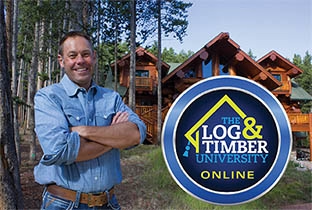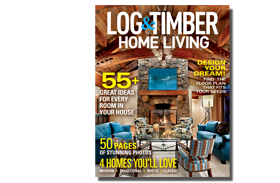
A log cabin is not a singular thing. Though every house is made of up the same primary building material — wood — the way in which that wood is cut and crafted plays a significant role in the home’s design. The secret lies in the logs’ profiles and corner systems, and even the context of these characteristics has evolved over the years.
Take square logs, for example. Historically in North America, this profile, locked together by a dovetail corner system, was a surefire sign of a house located in Appalachia or the southeast corner of the United States. Likewise, round-on-round stacked logs joined by saddle-notched corners have been hallmarks of the log lodges of the West.
Twenty years ago, to build a log home or cabin that didn’t subscribe to its geographic vernacular was all but unheard of. No longer, proclaims Celeste Haase, design manager at M.T.N Design, the architectural arm behind PrecisionCraft Log & Timber Homes in Idaho. “Customer preference, not location, drives what the architecture will be now,” she says.
Today’s log homes use profiles and corner systems as design elements to achieve a particular look and feel, not as a method of regional homogeneity. According to Celeste, the clean lines of square/dovetailed logs are an ideal complement to a modern log home aesthetic, and a round-on-round/Swedish-cope cut is a perfect way to get that storybook cottage appearance, no matter where the structures are located.
Case in point, Michael Grant, co-founder of Georgia-based Modern Rustic Homes, was asked to design and build a European-style hunting cottage located nowhere near Europe.
“My client wanted his house to feel like a lodge, but still be cozy and intimate. During my research, I could see common influences among well-crafted European houses, including great attention to the joinery,” he states. “My solution was to use rectangular shaped logs and dovetailed corners coupled with wood planks, shakes, stone and timber framing.”
Those seeking that cabin-in-the-woods vibe have log profile and corner options in varying degrees of rustic ranging from refined to rugged. “You can go with a round profile with a simple, blunt edge or a beaver-tooth corner in which each log course staggers at varying widths and lengths,” Celeste shares. “And then there are pencil-tip corners, which each log is cut to a point to create a very old-school-rustic look.”
Other corner options include butt-and-pass, in which every other log extends several inches beyond the joint, like interlaced fingers (see the photo, left), and corner post, where the logs end in a vertical cap, creating an orderly appearance. Each can be used with round, square, D-shape or tongue-and-groove profiles.
“My takeaway is that all the design elements must come together to provide the best solution,” says Michael. “Inspiration is extracted from each of these influences, and when we embrace the challenge, we are sure to get a good result.”
See also: Profile and Corner Systems for Log Homes











